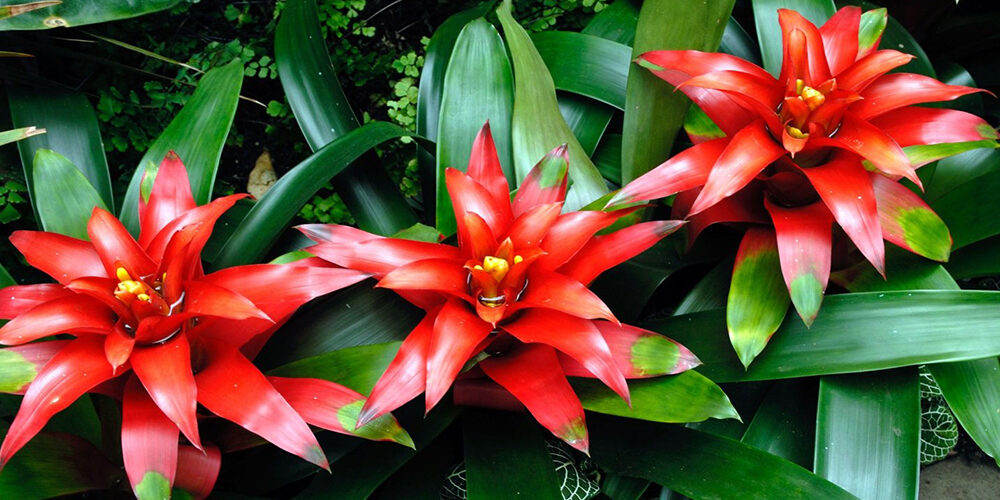Growing Bromeliads

Bromeliads spend their lives as houseplants in places that aren’t as warm as the tropical climates they call home. Their brightly colored bracts (which we think of as their flowers) can last for months, brightening a dark corner.
One of the most cold hardy is matchstick bromeliad (Aechmea gamosepala), an ornamental plant from Peru which can survive in USDA growing zone 9. But as a general rule of thumb, pamper these hothouse plants indoors unless you live in a warmer climate (most prefer USDA growing zone 11). With their evergreen leaves that spill out from the center, bromeliads have a rosette shape. Most are epiphytes and would prefer to grow on trees or rocks where their roots enjoy excellent drainage: do not let them sit in soggy soil in a planter.
Bromeliad is the name for a family of plants with more than 3,000 different species (one surprisingly being the pineapple). Native to tropical climates, in places that aren’t as warm Bromeliads spend their lives as houseplants. Their original habitat is humid shady forest floors or they are found attached and hanging to trees like botanical monkeys. This means Bromeliads are adapted for warm, wet, shady climates.
Brightly colored leaves often mistaken for flowers are actually bracts, leaf-like structures where an inflorescence may grow. Slowly a Bromeliad adds new leaves to its center, and then when the center becomes crowded and new leaves have no room to form, the Bromeliad focuses its energy on producing offsets.
A Bromeliad’s bloom can last several months and the colorful bracts even longer. Sadly though, the mother plant eventually dies (and you do not have a black thumb) but hopefully not before producing offspring to continue the family.
Planting
- Bromeliads look stunning grouped together as one type, or mixed with other varieties under the base of palm trees and bamboo, placed around swimming pools, or decorating a modern shaded entrance.
- Seek out unique varieties that have exotic leaves in bold colors or striped like a snake. One of the hardiest varieties worth looking for is Fascicularia bicolor with its prickly leaves and otherworldly flowers.
- Some Bromeliads grow well as “air plants,” which can be nestled into logs, moss, or other organic structures.
Care
- Knowing the variety will help you integrate Bromeliads into landscape and properly care for it. If unsure, ask a nursery professional. If planted outside in a frost-free area, avoid exposing your Bromeliad to large amounts of direct sun or leaf burn will occur. Bright light is best. If you worry about freezing temperatures, plant Bromeliads in containers that can be easily moved to sheltered areas when frost hits.
- Most Bromeliads dislike ordinary soil or potting soil because it does not drain properly and rots the root system. Instead, use specific Bromeliad potting mixes. The same applies for fertilizer; use a type designed for orchids but fertilize sparingly.
- Remove the flower after it becomes unsightly, using a sharp, sterilized knife or pair of scissors to cut back the spike as far as possible without injuring the plant.
Website: www.gardenista.com